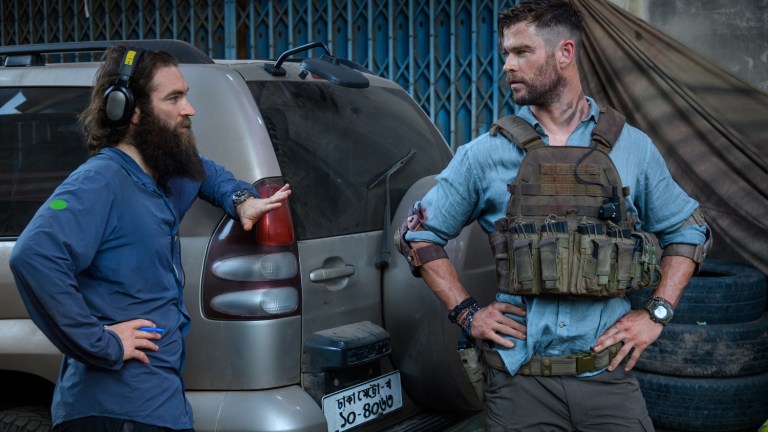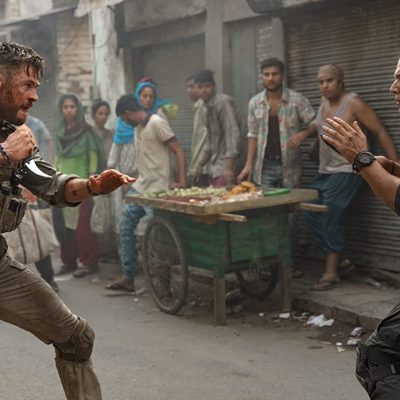Extraction: Bringing the Netflix Chris Hemsworth Movie to Life
Extraction has got lots of Chris Hemsworth and lots of heart, says director Sam Hargrave.

In Extraction, a mercenary for hire named Tyler Rake (Chris Hemsworth) is on a seemingly impossible mission: rescue the teenage son of one imprisoned drug lord from another, an immensely powerful criminal chieftain who has almost unprecedented control over the teeming city of Dhaka, Bangladesh, its law enforcement and even its street urchins.
Rake is a killing machine, capable of dispatching swarms of assassins almost singlehandedly, but he’s also tormented by demons of his own and an unspeakable tragedy from his past. As he and his team face new dangers and betrayals around every corner, his mission becomes not just a path to redemption but a harrowing journey of survival.
Extraction is an original movie produced for Netflix by Anthony and Joe Russo, the directors of historic Marvel blockbusters like Avengers: Infinity War and Avengers: Endgame. While Joe wrote the script — based on a graphic novel he penned a decade back called Ciudad — the Russos turned the directing duties over to first-timer Sam Hargrave, stunt coordinator for both those Avengers films and second unit director for Infinity War, as well as films like Atomic Blonde.
Hargrave’s eye for immersive action and mind-blowing stunts serve him well in Extraction, which features a showstopping 11-minute action sequence midway through the movie among other highlights. But as Hargrave tells us in our phone interview, action means nothing without character and story, a truth he wanted to put to the test with his first full-fledged directorial outing.
Den Of Geek: How are you doing today? How are you holding up?
Sam Hargrave: Good. Just staying busy, doing a lot of writing, reading, working out. Trying to stay positive.
Good for you. You’ve wanted to make the leap into directing for a while, so what made Extraction the right vehicle for that?
I was working with Joe and Anthony Russo on Avengers: Infinity War. I was coordinating and second unit directing and Joe approached me with a script, and he said, “I think this could be a great first movie for you.” He was aware that I had been wanting to direct. We’d spoken about it through the years as our relationship grew, and as he was mentoring me more and more.
I gave the script a read, and it was very familiar to me because I’d actually read a version of that script eight years ago or so. It was under a different name then, it was called Ciudad. I liked it at the time, and still like it, because wrapped up in this muscular fast paced action thriller was a story about a man on a road to redemption.
It’s just a very heartfelt story. To me, very relatable about making some questionable decisions and then having to live with that and then make up for it hopefully. It was a really heartfelt story with a lot of action and I thought, hey, this really is a great script and something that I think I could put my stamp on and a good one to get out there for my first feature.
You’re a veteran stunt coordinator and you’ve done second unit work. A lot of what you do overlaps into the directing realm, but what’s the major difference when you’re the sole guy at the top yourself?
The sheer volume of questions is unbelievable. I mean, when you’re running a stunt department or you’re directing your second unit or whatnot, yeah there’s questions, but you’re just handling one department. When you’re overseeing the entire thing, when you’re the director, everyone comes to you with questions, needing answers so that they can do their job. In no way is it like, “Oh my gosh, enough with the questions,” because if they don’t ask the question we can’t make a movie. That was something that took some getting used to for me. It was just the sheer volume, the number throughout the day.
You’ve just finished a dramatic scene and you’re thinking, okay, how do I make this better? But then somebody comes over and asks, “We’ve got to get this thing ready by the end of the day for the shoot two weeks from now, how many bullet holes do you want on the side of the blue car?” Your brain has to do a complete 180 and start thinking technically now, about the special effects for the big action sequence two weeks down the road. Just the way your mind has to bounce around from topic to topic and keep it all compartmentalized was a learning process for me.
What kind of insight into the job did you glean from working with the Russos?
I think one of the biggest lessons that I took from working with the Russos, is planning and preparation. They’re very prepped. Going into things, you want to know what you want to accomplish and be able to communicate that to the crew. But then because of that, you also need to have the ability to improvise and do whatever is best for the shot, best for the sequence, best for the movie.
Sometimes you’d be like, oh, this is what we’re going to do, this is the plan, but then you get there and something’s not feeling right or something better comes up and you just have to have the confidence to trust your gut and trust that you’re prepared enough to make subtle changes that will make the end result even better than when you went into that scene.
Coming from the background of stunt coordination, are stunts, in a way, character work? Is part of your job to maintain a consistency between what the character does physically and what their inner life is?
Very much so. Action and character are completely related and I don’t think you can have one without the other. Because for me, I always try to approach action from the standpoint of character and story, so it’s never action just for the sake of action. It should always move the story forward or reveal something about the character. So as a stunt performer, you are as much the character as the actor is, you’re just the physical embodiment of that.
So you need to understand acting, you need to understand the character and story. For me, it’s how I approach it. And then, for an actor, they need to understand the physicality of the character — especially with a character like Tyler Rake — a full understanding of who this person is and how to best tell the story. So action and story and character are completely connected in my mind.
Chris Hemsworth doesn’t have a lot of dialogue in the movie. Was that a feature from the start or did that develop as the movie went along?
That was in the script originally. Joe Russo, I think, wrote a very kind of minimalistic — not a minimalistic character, but a man of few words. And the idea was to just say more through his actions and then to slowly have him peel back layers of the onion so he’s revealed throughout the movie, what his motivation is and where he’s coming from and who he is.
It actually played nicely for us because Chris was looking for something that was a different character for him. It’s a version of the 80s’, 90s’ action heroes, the strong, silent type, but with just a little more depth we tried to bring to it, a little more nuance to it, so that you really understand his motivation. Then you give the audience the satisfaction of revealing that late in the story. But I think it’s a pretty satisfying moment to reveal that in the movie.
How game is Chris himself, within reason and within the bounds of safety and insurance, to get into the thick of the stunts?
Chris is an unbelievably collaborative filmmaker and a committed partner. He was 110% committed to the cause. He’s smart, he understands that he can’t do everything and that he is the star and we can’t necessarily hit him with a car or throw him down a flight of stairs or over a balcony. But anything and everything that he could do…and we pushed him on this show because we really were relying on him, especially in this long extended sequence that we’re calling the oner, because we didn’t want to have to cut around things and use a double.
We wanted to stay in these long takes to really pull the audience in so they could experience this in real time with the characters, but that required Chris to be on camera for a long period of time performing complicated choreography. So he had to be in great shape and he rehearsed a lot with the stunt team. He would come back to the hotel after 12-hour shoot days and do two more hours of rehearsal for the next day’s work. He was so committed to the cause. He gave everything he had and I can’t say enough good things about him and what he did for the movie.
Joe Russo wrote this as a graphic novel originally a few years ago. Did you look at that in terms of inspiration for the look of the film or some of the shots in the film?
Not really. I was aware of it. I did read it, I did see it. It was awesome. The guys did great work and the script was very similar. But more of my inspiration when I sat down with Tom Siegel, the DP, and what I expressed to him, was my desire to make what we affectionately termed an arthouse action movie, because it was such a big action film, but at the core, it was a film with a heart.
So we wanted to have this — I don’t want to say independent feel, but have a very intimate and artistic feel and really try to dig deep into that local landscape and really find the colors and find those moments where you felt like you were there. Almost documentary style if you will, where you’re really in the space. Mostly our look developed from long hours of discussion with Tom and Phil Ivey, our production designer, and just trying to really capture that world in a way that was meaningful and unique.
People are really turning to Netflix and other streaming services these days while we’re all in quarantine. They’re looking for new content, and this is a new original movie starring a beloved actor. What are you hoping that people get out of it when they sit down and watch this?
Well, above all, these are crazy times that we find ourselves in, but regardless of that, whether it’s now or during normal circumstances, the goal for making a movie is that people have entertainment for however long the running time of the movie is, and especially now, when people are confined to their homes and have not a lot going on and so much anxiety presented to them by the outside world, that they can have a chance to escape. They’re going to lose themselves in a story and go along for the ride, be entertained, and hopefully feel something emotionally. And just have a small relief from all the craziness that’s going on in the world today.
Extraction premieres on Netflix on Friday (April 24).

